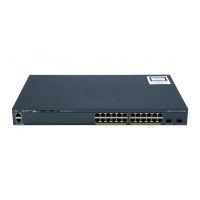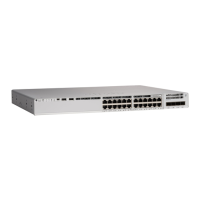1-14
Catalyst 4500 E-Series Switches Installation Guide
OL-13972-01
Chapter 1 Product Overview
Switch Features
for a maximum of 384 ports and 4 uplinks. With a Supervisor Engine 6-E, slots 8 to 10 provide 6 Gbps
per slot and all other slots provide 24 Gbps per slot. With a Supervisor Engine V or Supervisor Engine
V-10GE, all slots are 6 Gbps and E-series switching modules can not be used.
Table 1-4 describes the features of the Catalyst 4510R-E switch.
Ta b l e 1-4 Features of the Catalyst 4510R-E Switch
Feature Description
Ethernet speeds • Ethernet (10BASE-T) interface to workstations and repeaters
• Fast Ethernet (100BASE-T) interface to workstations, servers, switches, and
routers
Note Autonegotiation of link speed on each 10/100 port allows migration to
100BASE-T from a 10BASE-T installed base.
• Gigabit Ethernet (1000BASE-T and 1000BASE-X) interfaces for backbone
interconnection of high-performance switches and routers
• 10-Gigabit Ethernet interfaces for backbone interconnection of
high-performance switches and routers
Standard equipment • Ten-slot modular chassis with one slot reserved for a supervisor engine, one
slot reserved for a redundant supervisor engine, and eight slots for switching
modules
• Two power supply bays
• One hot-swappable fan assembly
Power supplies • Can support a 1400 W, 2800 W, or 4200 W AC-input power supply or a
1400 W DC-input single or triple-input power supply
1, 2
• Optional redundant power supply
Supervisor engine
support
• Supports the WS-X4516, WS-X4516-10GE, and WS-X45-Sup6-E
Supervisor Engines
• Holds the ASIC-based forwarding engine (data path) and the management
processor and software (control path)
• Features interface monitoring, environmental status, and SNMP and
console/Telnet interface
Note With a single supervisor, packets are not forwarded while the module is
removed; a system reboot occurs when a supervisor engine is reinserted.
In redundant systems, removing the active supervisor causes the standby
supervisor to become active.

